Brian May’s Legendary Deacy Amp and its background:
Brian May has used the ‘legendary Deacy Amp’ throughout his career to achieve his distinctive multi-layered guitar harmony sounds found on many famous Queen recordings and on his own solo records.
Some of the better known songs which feature the Deacy Amp’s unique tones are: Procession (Queen II), Killer Queen, Lily Of The Valley (Sheer Heart Attack), Love Of My Life, God Save The Queen (Night At The Opera), Millionaire Waltz (Day At The Races), All Dead (News Of The World), Dreamer’s Ball (Jazz), Flash’s Theme (Flash Gordon), Made In Heaven, A Winters Tale (Made In Heaven), Why Don’t We Try Again (Another World – Brian May’s 2nd solo album)
In 1998 I spent much of the year at Brian’s London Allerton Hill studio. Brian had asked me to completely overhaul and refurbish his famous Red Special guitar, and little by little other interesting projects were added to the list. The work was fascinating and absorbing, and the Deacy Amp became one of these intriguing research and development projects.
On several occasions during 1998 Brian described to me how he used his Red Special guitar and treble booster – played through the tiny pint sized 1 watt Germanium transistor Deacy Amp – to create his trademark multi-layered guitar harmony sounds.
Brian said that his use of ‘John Deacon’s small amplifier’ to achieve his multi layered guitar orchestras – ie that using this ‘Deacy Amp’ for the job instead of a regular guitar amp – somehow produced a recorded sound on tape that made the multi layered harmonies ‘sit together in a more symphonic way’ – compared to how it would have sounded if Brian had used his usual stage amps – the Vox AC30s – for the job.
On some recordings Brian has also used the Deacy Amp for the main guitar solo sound instead of the Vox AC30. In this role the Deacy gives a distinctively different guitar sound – less round and full than the AC30 – more like having a peg on your nose to use a humorous example – but still extremely toneful and rich with an almost ‘other worldly sound’ as Brian once described it to me.
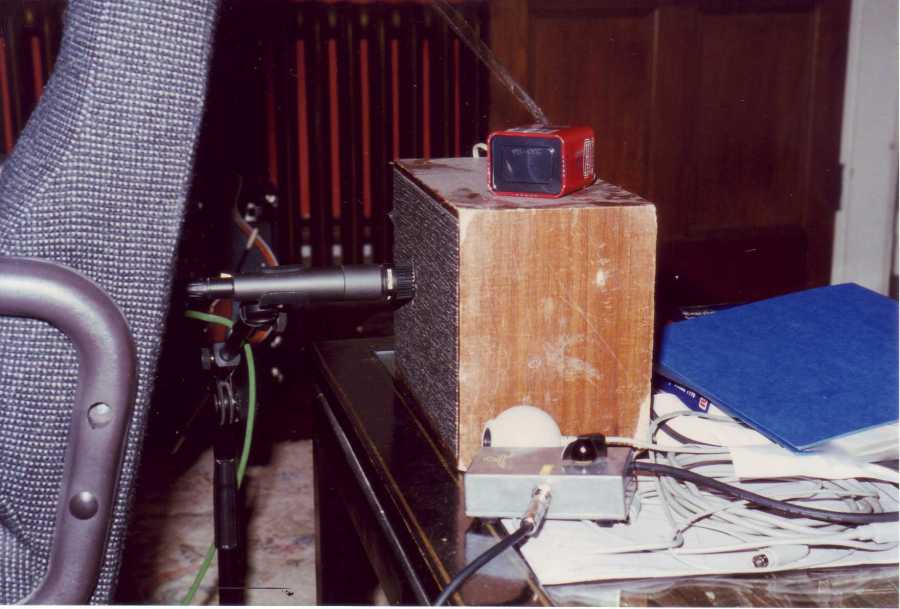
The Deacy Amp being used by Brian May during the recording of ‘Another World’ album at Allerton Hill studio February 1998
A good example of Brian May’s use of the Deacy Amp for his trademark multi-layered guitar sounds on Queen recordings can be found in the following YouTube video:
The second video shows a rare ‘live in the studio’ recording done at VH-1 studios in London on 22nd May 1998. Several songs were recorded by Brian and his band at VH-1 shortly before a world tour to promote the album ‘Another World’.
In this clip below Brian plays my Red Special replica ‘Paul’ through his original Deacy Amp. Right from the first seconds you can hear the Deacy Amp’s unique tones, with Brian’s main solo piece using the Deacy kicking in at 3.06:
Lots of Deacy Amp rich guitar harmonies can be heard right from the opening seconds of Dreamers Ball. The amp was used by Brian all through this fabulous song from Queen’s “Jazz” album, with the Vox AC30 occasionally used for contrast such as during the main guitar solo section:
On 6th February 1998, with Brian’s blessing, I nervously opened up the Deacy Amp and began taking it apart, photographing it and recording its dimensions and circuit board etc.
Brian May told me that no one had taken the amp apart from the time that John Deacon brought it along to Queen band practice back in the 1970s. This was a huge honour. I discussed with Brian the idea of building a spare amp or two which could act as a backup for him if anything was to ever go wrong with the original Deacy Amp. We also discussed the idea of eventually making bespoke versions of this amp for general sale to musicians, and both Brian and I agreed that this would be a good thing to aim for in the future.
Around March-April 1998 I contacted well known Vox AC30 amp expert David Petersen on behalf of the studio because Allerton Hill didn’t have a good amp technician to call for repairs and modifications to Brian’s amps. Later I asked David if he would like to be involved with assisting me to make some Deacy Amp replicas. Fortunately David said yes and in June 1998 we began the Deacy replica project.

Deacy Amp sinewave asymmetric clipping: I visited David Petersen’s workshop in Old Woking in July 1998 and brought along the Deacy Amp for some tests. David tested the Deacy with his signal generator and scope and this showed us how the amp clips in a very asymmetrical way, which is undoubtedly one of many important reasons why the Deacy Amp sounds so unique
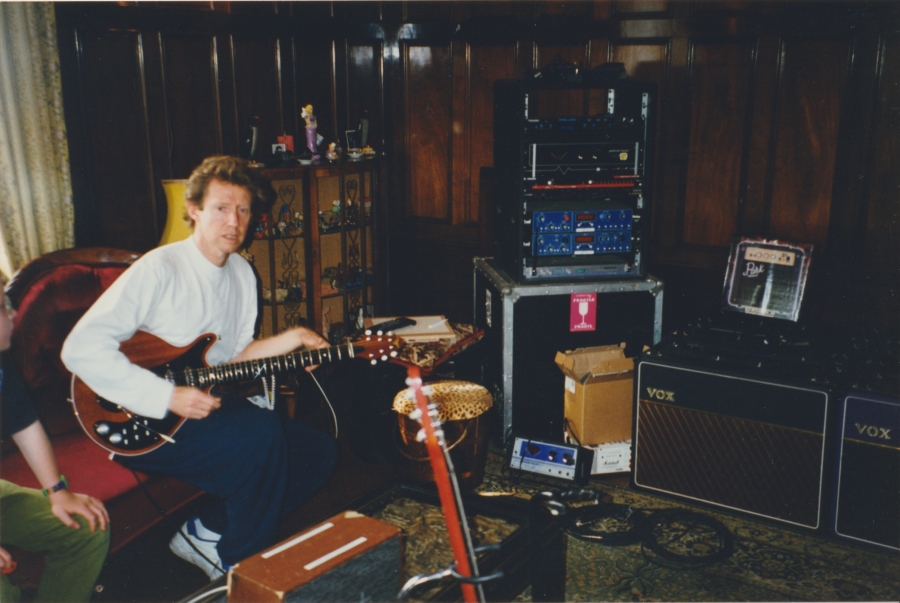
Allerton Hill studio July 1998: me noodling away on my Red Special replica ‘John’ with Mark Reynolds’ Red Special guitar and Deacy Amp in foreground. Pic by Mark Reynolds
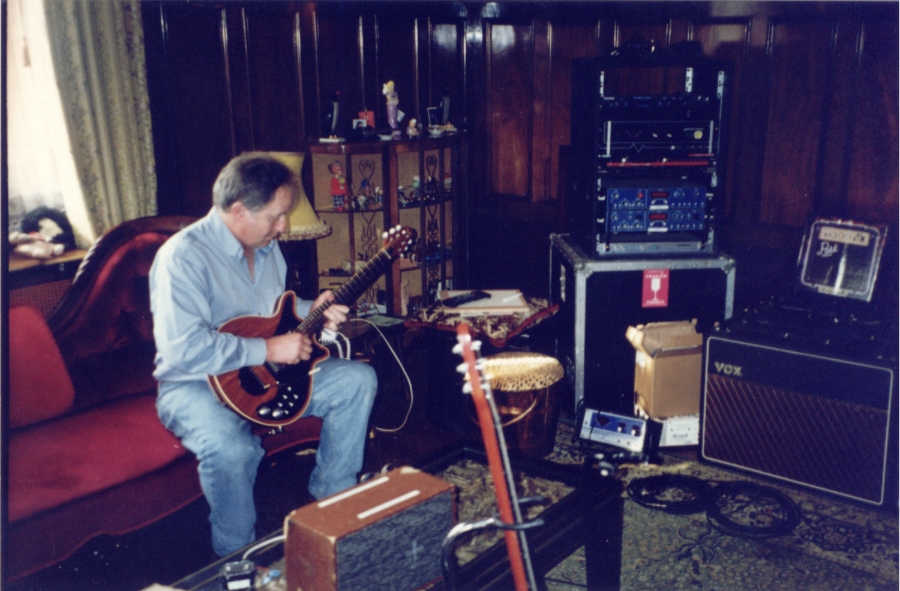
Richard Foxell (who assisted us by supplying the old style Rustins Plastic Coating for the Red Special resoration work plus lots of specialist advice) noodling away on my guitar ‘George Burns’ with Deacy Amp in foreground. July 1998. Pic by Mark Reynolds
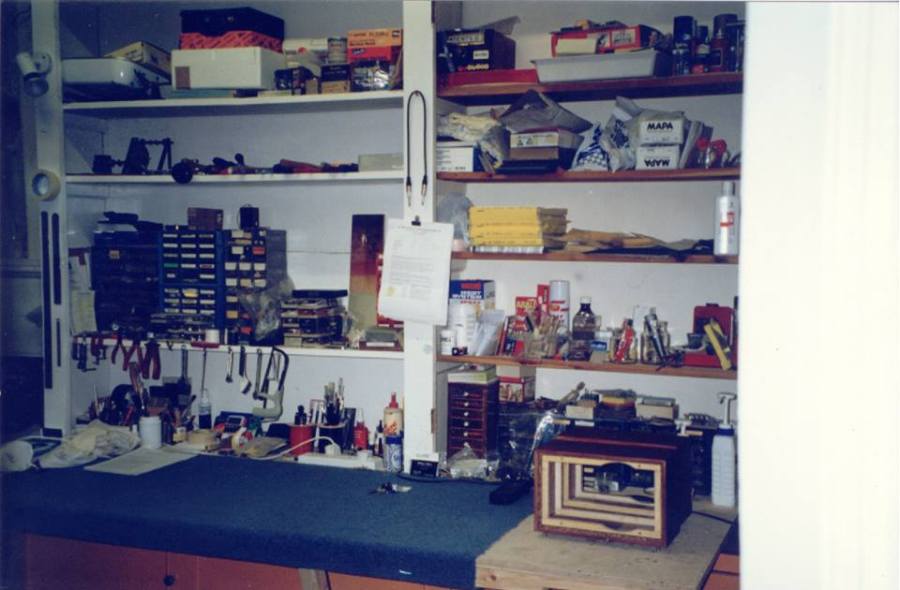
My workshop at Brian’s Allerton Hill studio with the Deacy Amp replica cabinets under construction on the bench at right. 3 Deacy Amp replicas were being built by myself and David Petersen. Pic by Mark Reynolds July 1998
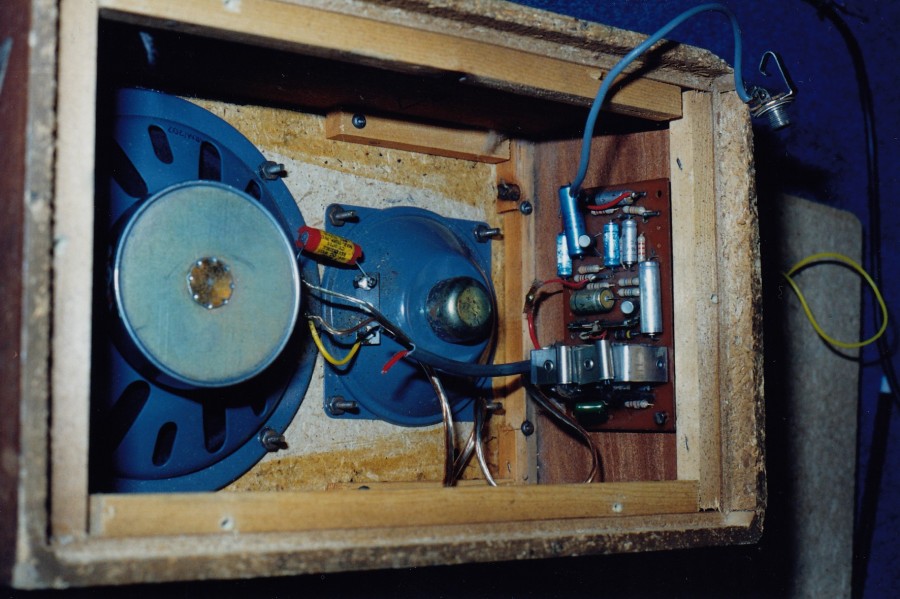
The ‘holy grail’: the amp’s circuit board was originally fixed onto the cabinet wall with 2 nails when I first opened up the amp on 6th February 1998. I decided that 2 screws were a more solid and better choice and used two 4 gauge X 5/8″ long pan head screws. Brian told me that the Deacy Amp had not been opened up since the 1970s to the best of his knowledge. An amazing piece of rock music history!
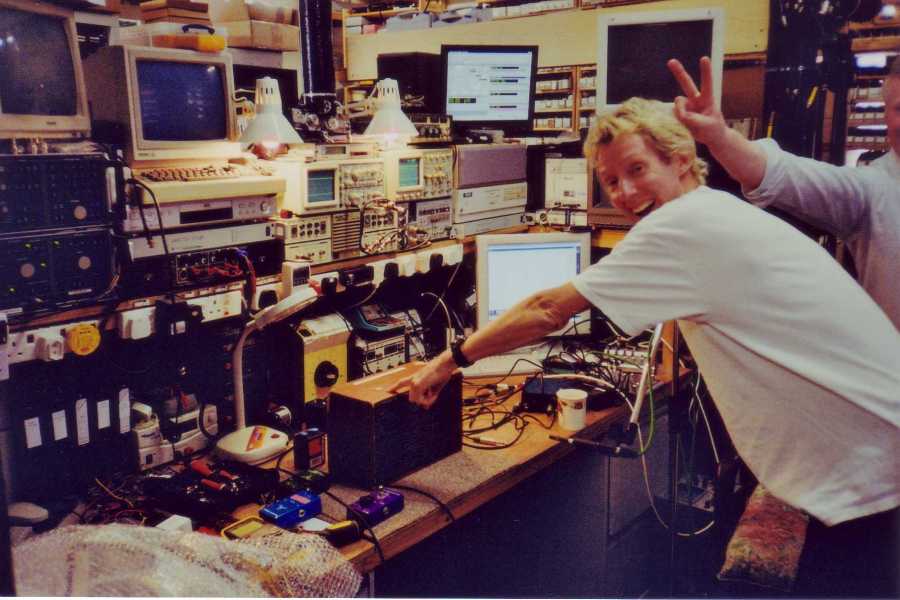
Deacy boffins hard at work: a not-so-serious moment at Nigel Knight’s mate Chris’ workshop at Newport UK March 2007. We were trying to crack the the Deacy Amp’s many mysteries. Chris, otherwise known as ‘the educated man’ is giving me the ‘v-sign’ rabbit ears….thanks a lot Chris
============================================================
My phone call interview with ‘Queen’ bass player John Deacon on 22nd July 1998:
John was a very nice fellow to talk to and gave his account about finding the Deacy Amp circuit board and then what happened with putting the amp together and using it as a practice amp, and then taking the amp to band practice with Freddie, Brian and Roger.
By the way, John Deacon did not tell me that he changed the Deacy Amp’s front end – this came from something that Brian had told me during 1998 at Allerton Hill when we began pulling apart and examining the Deacy Amp. Brian said that he thought they had changed something in the amp to help it cope better with the signal coming in from the treble booster. We are not sure whether or not this happened, and in 2007 when I asked Brian again about it, he laughed and told me that he couldn’t remember.
In the piece I wrote for Brian’s website www.brianmay.com about the Deacy Amp, I included this information based on what Brian had previously said, but my thoughts now are that there may have been no alteration made to the front end of the amp.
In the phone call with John Deacon I also asked him if he had ever made Brian a treble booster in those early days of Queen, because for many years it has been reported that he had. John told me that he had not made a treble booster for Brian.
From my notes on the phone call with John Deacon 22nd July 1998:
John said that he found the amplifier section in the back of a skip which was sitting on the side of the street in London, and that he noticed the wires dangling over the edge of the skip and picked it up before it was thrown out. John said that he was studying for a degree in Electronics at the time and was always tinkering with electronic bits and pieces, and that the circuit board looked interesting to him when he first saw it. He thought that the transistor amplifier might have come from a cassette player or a radio. John thought at the time that he might possibly use it as a small practice amplifier – he played guitar as well as bass. John thought that this had happened in about 1972 and that he was already playing with Brian at this time.
John said he already owned the hi-fi bookshelf speaker box which he then modified so that it housed the amplifier circuit board inside with no controls at all on the outside of the box. John liked the simplicity of only having a jack socket to plug into with the amp’s volume set internally at full, although he said that initially he probably had a volume control hanging on the outside somewhere. The amp had a warm and pleasant sound although John said that it was always partly distorted and would never sound clean.
John told me that through some chance he showed the amp one day to Brian when he brought the amp along to band practice, and said Brian was immediately interested in the amp’s possibilities especially when he used his Red Special guitar and treble booster with it. John said that with the Red Special and treble booster, the little amp offered a pleasant pretty type of saturated distortion which was utterly unique and very different to the ‘cutting harder sawtooth transistor distortion’ found in many effect pedals and amps of the time.
John remembered that the sound engineers who they worked with liked the way the little amp behaved in the recording studio where it would produce a ‘consistent response’ as he termed it, whereas the engineers found it more difficult to capture on tape the excitement and dynamic live sound of Brian’s Vox AC30 amps. However John quickly mentioned that all the work and discussions with sound engineers was never his area of interest, and therefore he was never privy to detailed information in this area.
When I asked John about whether he had made a treble booster for Brian at this time in the early/mid 1970s, he told me that he had not.
============================================================
Origins of the Deacy Amp circuit:
In 2013 Dave Doughty, Mitch and others at http://www.antiqueradios.com finally established that the Deacy Amp pcb is from a Supersonic PR80 portable radio.
http://antiqueradios.com/forums/viewtopic.php?f=4&t=213655&start=20
Interestingly, John Deacon had originally told me in 1998 that the circuit might be from ‘ a cassette player or radio’ so it looks like his intuition was correct.
In 2014 Manuel Angelini from France located an original Supersonic PR80 circuit board which appeared to be identical to that of Brian May’s Deacy Amp. Manuel has now become the world expert on the Supersonic PR80 and has done extensive research on the Supersonic factory in Rhodesia during the 1950s and 60s and the Supersonic PR80’s origins.
Manuel Angelini’s website: http://doxyworld.com/
Manuel’s Youtube video ‘A Supersonic Story’ shows some of the Supersonic PR80 radio’s origins. I like the suitably theatrical ‘over the top’ music:
https://www.youtube.com/watch?v=rFw66tCP_IE
============================================================
Designer of the Deacy Amp circuit: Nigel “Bob” Goodridge
This article was written by Nigel’s son Peter Goodridge on 3rd June 2020 and has been very kindly provided for publication:
“I was not aware of the mystery of the Deacy Amp and the Supersonic PR80 radio until I was on Facebook and someone had posted a picture of the old Supersonic Radio Factory in Bulawayo in what was then Rhodesia. I responded and posted that my late Dad, Nigel “Bob” Goodridge was the Chief Design Engineer at Supersonic from 1961 until the late 1970’s and was responsible for the design of a large number of portable radios, car radios and stereo hi-fis during that time.
Nigel Goodridge, better known to his friends as “Bob” Goodridge as he didn’t like the name Nigel was a Radio Officer in the Royal Navy during the Second World War and became an Engineering Apprentice with PYE Radio in the UK after he was de-mobbed from the Navy.
During the early 1960’s he was headhunted in London by Jacques Chassay who was the founder together with his brother of Supersonic Radio in Bulawayo, Rhodesia in the 1950’s. My Dad took the whole family from the UK to Rhodesia in 1961 and commenced his role as Chief Design Engineer at the Supersonic Radio Laboratory in Bulawayo.
During this time he was responsible for the design and development of a large number of portable radios, including the PR80 which were designed specifically for the local market in Rhodesia and South Africa.
I can remember as a young boy and a teenager growing up in our home in Bulawayo always surrounded by music, radios and hi-fi sets and how excited my Dad would be when he brought home one of his designs for us all to test drive. He was a very modest man and went about his work with immense enthusiasm and passion.
He left Supersonic when he and my Mum, Joan Goodridge decided to move to Johannesburg in South Africa in the late 1970’s. He remained very involved with the radio industry and was a Consultant to a number of Companies in Johannesburg.
Nigel “Bob” Goodridge passed away in April 1992 in Johannesburg after being diagnosed with a brain tumour in November 1991. I only wish that he could have had some idea how his design of the PR 80 would have had such an impact on the music of Queen.”
Peter Goodridge (petergoodridge@hotmail.com)
Sydney, Australia
3rd June 2020
pdf of Peter Goodridge’s article
Peter Goodridge – Deacy Amp Supersonic PR80 article 3rd June 2020
===========================================================
8th June 2020:
Following on from Peter Goodridge’s article above, I asked Peter if he would mind writing for us a slightly more detailed biographical piece about his father Bob. Given that Bob is now being recognised by the guitar world as the designer of Brian May’s famous Deacy Amp circuit, I felt it worthwhile for people to be able understand more about the person that Nigel “Bob” Goodridge was, and comprehend the circumstances which shaped his life and then took him and his family from London to a life far away in Rhodesia in the early 1960s when Bob accepted Jacques Chassay’s offer of being Chief Design Engineer at Supersonic Radio Laboratory at Bulawayo.
Peter has very kindly written this article and provided some photos of his dad Bob:
Nigel ‘Bob’ Goodridge – Electronics Designer – Biography by Peter Goodridge
“Nigel Robert Goodridge was born on 4th May 1924 in Weymouth England. He was an only child although he had two much older step-brothers from his Mother’s first marriage.
Bob joined the Royal Navy at a very young age as a Cadet Officer and then World War II broke out. He attained the Rank of Sub Lieutenant and spent a lot of time in the North Atlantic as a radio officer protecting convoys and then later in the Middle East. Bob has an “oak leaf” on one of his medals which means he was mentioned in despatches for some acts of bravery, but he later never spoke about it.
He got the name Bob in the war because he thought Nigel wasn’t a very masculine name so he told everyone he was Robert Goodridge, using his middle name instead, and they started calling him Bob. Later everyone in Bulawayo Rhodesia knew my Dad as Bob Goodridge.
Bob met his future wife Joan at the end of the war and they married in 1947. Bob was still in the Navy at that time but Joan was not happy about him being away so much, so he decided to leave and study electronics at the University College Southampton.
My Dad then joined PYE Radio in the UK as an apprentice. Fast forward to 1961 when we were living in the UK just outside London, when Bob came home and said we were all going to live in Africa in Southern Rhodesia as it was known then. He had been recruited by Jacques Chassay (the original owner along with his brother Arthur of Supersonic Radio) who had been in the UK recruiting for skilled employees.
Bob left for Rhodesia first and then the rest of the family joined him three months later….my Mum, my older sister Carole and myself. We moved to Bulawayo and by then my Dad was well established in his role as Chief Design Engineer at Supersonic.
Bob was responsible for designing a large number of portable radios, car radios and stereo hi-fi systems, and amongst them was the PR 80 (Portable Transistor Radio FM/AM).
My Dad had some health issues in the early 1970s due to angina (hardening and narrowing of the arteries of the heart), and his doctor told him that if he didn’t stop smoking and lose some weight he was going to die a young man. Dad got a fright and stopped smoking very soon thereafter and then started jogging around the block to lose some weight.
The jogging became an absolute obsession with my Dad, and he eventually became one of the top long distance runners in his age category in the country. He ran a great many marathons and half marathons. By the time of the mid-late 1970s the Rhodesian War years were upon us and I had left school and joined the Police in CID and then I was seconded into Special Branch.
My Dad was still at Supersonic but by the end of the 1970s he and Mum decided that Rhodesia was not going in the right direction so they left for Johannesburg South Africa where I was already living, having left Rhodesia in 1978. My sister Carole had earlier gone back to the UK to live in Wales, where she still lives today.
Dad then worked for an electronics company in Johannesburg on a consultancy basis, although I can’t remember their name. He travelled regularly to Japan on business and it was on one of these trips in 1991 that he collapsed. In November 1991 the doctors in Johannesburg diagnosed an aggressive brain tumour and gave him three months to live.
It is the only time I had ever really lied to my Dad as I went to the hospital with him and the Doctor took me aside and told me it was three months. My Dad knew he was sick and when I walked back into the room he just said “how long have I got?” I told him 6 months. I just couldn’t tell him three, it sounded too short.
Bob passed away on 15th April 1992, nearly exactly three months after his diagnosis. Dad was my best friend and I miss him greatly still.
I hope this gives you some insight into the remarkable man who was Nigel “Bob” Goodridge.”
Kindest regards,
Peter Goodridge
Sydney Australia
8th June 2020
==========================================================
4th June 2020:
Manuel Angelini has kindly provided an article and photos for publication which describes the background of the Supersonic company and the key people who were responsible for the development of the Supersonic PR80 radio
“Supersonic PR80 – the men behind the radio by Manuel Angelini:
It all started in 2013, when the good guys at antiqueradios.com identified the Deacy audio amp board as coming from a Supersonic radio, manufactured in Southern Rhodesia in the mid-1960s. That was a real breakthrough, as no-one before them ever had a precise idea about the Deacy origins.
Supersonic has quite a unique story. Created at the beginning of the 1950s by two brothers, Jacques and Arthur Chassay, who were of Canadian origins, it became one of the main manufacturers of radios in Africa, selling its radios, radiograms, gramophones… worldwide by the end of the decade. Most of the parts they used for their radios were designed and manufactured in-house.
This was possible because they had chosen to have a strong designing team. In those days, Supersonic had about 5 electrical and 5 engineering designers from a total laboratory compliment of around 12 people. An electrical and mechanical person worked together on each product. The electrical engineer was responsible for the circuitry, schematic, layouts and component details, and the mechanical engineer did all the drawings, chassis and cabinet designs.
By the end of 2013, I have been in touch with many former Supersonic employees, many of them remembering fondly of their time in the company. We talked about the people they were remembering of, and two names were often coming up : Bob Goodridge and Dave Sharpe, who were working in the development lab in the 1960s. They knew Bob Goodridge had sadly passed away at the beginning of the 1990s, but no-one knew where Dave Sharpe was living. I was lucky to get in touch with someone who knew him, because they were running together in their Rhodesian days, and I managed to get in touch with Dave Sharpe. Dave confirmed that Bob Goodridge and himself designed the Supersonic P.R.80, the radio that was to give birth to the Deacy amp, used by Brian May in many Queen songs. This was a fantastic surprise for him, and he was happy to tell me much more about Supersonic and its history.
Fast forward 7 years. As I own many pictures of the Supersonic people and premises in the 1960s, I posted one of them on Facebook, on a Rhodesian page. I had many posts and “likes” from people having worked there across the years. But one person also posted about his Dad : Peter Goodridge, son of Bob Goodridge. We then exchanged many e-mails about his Dad, and his design work for Supersonic. The Deacy/Supersonic P.R.80 story was such a surprise for him, but also brought back so many personal memories… because of its tone and history, the Deacy is really a unique amp !”
Kind regards,
Manuel Angelini
3rd June 2020
Manuel’s article as a pdf: Supersonic PR80 – the men behind the radio by Manuel Angelini
Manuel Angelini’s website: http://doxyworld.com/
===========================================================
History of the Greg Fryer/Nigel Knight Deacy Amp replica 1998-2011:
Below is an article in red text that I wrote in 2011 for inclusion in the KAT produced Brian May Deacy Amp, and since then I have edited some parts for more thoroughness and detail. I intend to post more detail and photos soon about the early years of my Deacy Amp replicas and research. Cheers, Greg Fryer 3rd June 2020
The Deacy Amp project was began by myself during the work I did in 1998 for Brian May at his London Allerton Hill studio. Brian gave his encouragement to me opening up the Deacy Amp and investigating its unique circuitry and speakers. Technical assistance came from David Petersen who I initially contacted in early 1998 on behalf of Brian’s studio to help with Brian’s Vox AC30 amp repairs and upgrading. After I then received the OK from Brian to investigate making 3 replicas of the Deacy Amp I asked David if he could assist me with replicating the germanium transistor/transformer coupled amp circuit of the Deacy.
One thing led to another as the ‘Deacy Amp research’ momentum grew and in July 1998 I had the wonderful opportunity of interviewing Queen bass player John Deacon regarding the origins of the Deacy Amp.
In mid August 1998 I returned home to Sydney Australia, and I brought back one of the Deacy Amp replicas made by David Petersen and myself. I then set about continuing the Deacy R&D process and made further prototypes with assistance from Colin Bloxsom who was a Sydney luthier and guitar electronics expert. Our best sounding prototype Deacy replica was what I call the Mk II, and to my ears this is still the best sounding Deacy Amp that I have heard apart from Brian’s original Deacy Amp itself.
Photos of Deacy Amp replica Mk II courtesy of Kees Van Ede:
In 2003 I asked Nigel Knight to assist me with technical expertise in the Deacy Amp project, and over several years we developed further prototypes which I then showed to Brian May on 2 trips to the UK in 2005 and 2007.
In early 2008 Nigel asked to take over the R&D task completely. The prototypes that we had developed during 2003-2008 were good sounding but disappointingly were not an improvement soundwise on my 2003 Mk II Deacy and we were at a frustrating point with the amp’s development. We were obviously hoping to make the Deacy Amp for commercial sale at a later date as part of the ‘Brian May/Fryer’ product range but there were still some obstacles to overcome technically. Against my better judgment, I agreed to let Nigel Knight take over complete control of the Deacy Amp project. Nigel then met with Brian and Pete and decided to start again with a clean sheet and this meant that he re-examined the original Deacy amp to a higher degree than we had before. Previously we had been very reluctant to take apart several fragile areas because of the danger to this irreplaceable amp.
Since January 2008 there has been a great effort from Nigel Knight in order to get this simple looking little amplifier produced and brought into being. Almost everything in this replica amplifier has had to be custom made specially for it and this has needed great amounts of time and expense devoted to the project.
Several people involved in the project have contributed articles to the Deacy Amp booklet – this part below in red is from my article:
Background of the Legendary Deacy Amp and the development of the replica by Greg Fryer:
In July 1998 John Deacon related to me the circumstances surrounding his putting together of this unique sounding amplifier and speaker cabinet.
John literally found the circuit board as he was walking down the street one day in London – this occurred in early-mid 1972 when he was first playing in “Queen” with Freddie Mercury, Roger Taylor and Brian May. Being a keen electronics experimenter (John was then studying for an electronics degree), his attention was drawn to the wires that were dangling over the side of a builder’s skip which was filled with rubbish and about to be taken away to the tip.
These wires were attached to a circuit board and John’s curiosity led him to examine the board to see if he could salvage it and put it to some use. He initially thought that the circuit board might have come from a battery operated cassette player or radio, and after inspecting it further decided it would do the job as a small practice amplifier for guitar (John played guitar as well as bass).
John coupled the newly found circuit board with a spare bookshelf speaker cabinet which he had lying around – the circuit board was fixed inside with two screws and the finished product featured no controls whatsoever. On the back panel of the cabinet was fitted a single jack socket to plug the guitar lead into – the amp’s power was turned on by simply connecting the two battery clips which came out from the back panel to a large 9 Volt PP9 battery.
With a standard guitar plugged in, John said the amp possessed a warm and pleasant if partly distorted sound, but lacked brilliance or much definition. However a new way of using this little amp was about to be found that would change its sound and make it an invaluable part of Queen’s recording armoury.
On one occasion John brought his practice amplifier along to band rehearsal and showed it to Brian. Immediately Brian was interested in the amp’s possibilities once he heard how it behaved when he plugged in his innovative home made Red Special guitar and his single transistor treble booster pedal. Using the guitar and treble booster together changed the amp’s sound dramatically, overdriving both the input and output stages and producing a richly distorted yet defined and sustained sound which resembled such things as violins, cellos and even vocals.
John commented that the rich saturated compressed type of distortion produced by the combination of Red Special guitar, treble booster and Deacy Amp was very unique and was different to the harder sounding distortion common at the time in many guitar effects and amps. He mentioned that the recording engineers that the band were working with particularly liked the way the little amp behaved in the studio. Here the amp would produce a consistent response John said, whereas the engineers found it more difficult to capture on tape the exciting and dynamic sound of Brian’s Vox AC30 amps.
John’s small amplifier became known as the “Deacy Amp” and featured regularly on Queen albums where Brian used it for his creative, highly original multi-tracked guitar orchestrations. These were painstakingly built up line by line (and even note by note on some of the more complex pieces such as “Good Company” from Night At The Opera). Although the Deacy Amp is a deceptively simple looking piece of equipment, the wide number of creative sounds that Brian has managed to coax from it over the years belies the outwardly simple appearance.
Brian has described the way that the Deacy Amp’s sounds sit and blend together when recorded as being “symphonic”, whereas when the AC30 was tried for the layered sounds it didn’t have the same character and effect in the way the notes blended together. The tracks “Procession” and “The Fairy Feller’s Master Stroke” from the 1974 album “Queen II” saw the first recorded examples on a Queen album of the Deacy amp.
Perhaps the best known example of the amp’s use is on “God Save The Queen” from 1975’s “A Night At The Opera”, whilst possibly the most unusual use was for all of the jazz band sounds on the song “Good Company” (trombones, clarinets and all!) from “A Night At The Opera”.
The Legendary Deacy Amp continues to this day in good health and continues to occupy an important place in Brian May’s recording studio.
Making of the Deacy Amp replica:
During the early months of 1998 as Brian May was completing the recording of the “Another World” album at his London Allerton Hill studio; Brian, Pete Malandrone and I discussed the idea of making a replica of his Deacy Amp. For some time Brian and Pete had been aware of the need to have a good quality replica as a backup for Brian’s own use in case anything ever went wrong with his original amp. Due to the great interest shown over the years in the Deacy amp we also thought it was worthwhile to start the process of examining the original amp so that we could possibly one day offer replica amps for sale.
At that point we had little idea of the amount of work that might be involved, how long it might take and how much it might cost, or who we might have to find as partners to be able to bring the project into physical reality and have amps eventually manufactured. As the project began I asked assistance initially from two friends in London and Sydney who were experienced guitar and amp repairers: Dave Petersen and Colin Bloxsom.
In July 1998 Dave Petersen and I built 3 replica amps which were assembled in Brian’s Allerton Hill studio, and after I returned home to Australia in late 1998 Colin Bloxsom worked with me on further development of the Deacy amp design. When Colin left to go overseas I then asked Nigel Knight if he would like to be involved in the Deacy development project.
I would personally like to thank these three gentlemen for their invaluable technical assistance, and in particular Nigel Knight. Without Nigel’s specialist electronic expertise and dogged determination to see the job through to the finish, the Deacy Amp replica would not have come about. I would also like to thank very much Brian May and Pete Malandrone who have always been very encouraging during the development of various Deacy Amp prototypes and have always been extremely generous with both access to the original amp and with their time during the years of development.
The first 3 replica amps that Dave and I built during July/August 1998 took a fair bit of guesswork regarding the driver and output stages. Plotting out the basic circuit was fairly straightforward but there were areas that kept on being an intriguing mystery until Brian finally gave the go-ahead to take everything apart in January 2008. Because of the fragile and delicate nature of these areas of the original amp (mainly the transformers and some circuitry immediately adjacent to the transformers), we were extremely reluctant to take the amp completely apart due to the risk of doing irrepairable damage. Dave assured us that the Deacy’s transformers were none that he had seen before and were not available commercially. Brian and Pete didn’t want to wind up with a non functioning Deacy Amp and I certainly didn’t want to be remembered as the man who killed the Deacy Amp! So we agreed to take educated guesses for the transformers (based at first on the old Mullard reference manual and advice from transformer manufacturers), and pinned our hopes that through trial and error we would eventually get the sound correct. There were some surprises and frustrations in store for us….
The speakers were also a critical part of the Deacy sound, and I tested many speakers for these first 3 amps in 1998. Fortunately we managed to find a very good sounding twin cone English made Eurotec 6.5″ speaker, and it was by far the closest sounding to the original Deacy amp’s English made Elac twin cone speaker. These 3 Mk I replica amps sounded surprisingly good in their own right although it was clear to us that there was still much work to do to achieve an identical sounding replica Deacy amp.
Back in Australia in late 1998, I continued the development work with Colin Bloxsom in Sydney and we asked specialist transformer companies to make new experimental coupling and output transformers which were to be wound to different specifications and in various lamination sizes and styles. We also experimented with several circuit variations. Throughout 1999-2001 we made the Mk II version of the amp which sounded closer again to Brian’s original Deacy and its elusive tonal and distortion characteristics.
In 2003 I asked Nigel Knight if he would like to become involved with the Deacy replica project, and he brought to the table his specialist knowledge of “Deacy era” 1950s-1970s transistor and valve electronics as well as his keen interest in Brian’s Red Special guitar. Over the next 4-5 years several prototype amps were built and modified whenever spare time was available, and we both had a lot of fun producing new versions of the amp and trying to crack the Deacy’s tonal mysteries. During this time we continued to refine the transformer specifications, trial new speakers and refine the overall circuit. In both 2005 and 2007 I visited London with prototype amps to show Brian and Pete (amongst other things like Red Special and AC30 stuff), and to make further examinations scope tests and A/B test recordings of the original Deacy amp. In the 2003-2007 amps we sometimes used a Phillipine made Dai Ichi twin cone speaker which was strong in some sonic areas that the Eurotec wasn’t. By 2007 Nigel and I had gone about as far as we could go based on our still incomplete knowledge of the Deacy’s transformers and circuit, and we were also in need of a speaker that would sound identical to the tonality, focus and volume of the original Elac. As good as our previous Eurotec and Dai Ichi speakers had been, they were just not the same as the old Elac so it was clear that we would have to take the extra step of finding a speaker company that was capable of producing a custom made replica of the Elac 6.5″ twin cone speaker, and who was also willing to commit the considerable R&D time towards achieving this.
In January 2008 Brian, Pete and Nigel got together to discuss the Deacy Amp prototype’s future, and to our great delight Brian decided that it was now time to take apart whatever needed to be taken apart from the original Deacy in order to be able to produce an identical sounding amp. Nigel then took on the task of conducting this vital final research work and also began the process of looking for suitable speaker manufacturers who could duplicate the Elac speaker, plus a host of other things.
To be able to produce a replica amp many issues needed to be solved including having custom made grillecloth screenprinted to the exact pattern of the faded original Deacy grillecloth, having custom mahogany veneered chipboard manufactured so that we could then manufacture speaker cabinets that were comprised of the same materials as the original amp, having our stocks of germanium transistors put through an involved and expensive process to make them RoHS compliant, plus a list of other things. Not the least issue to solve was the arduous development of the speaker, and fortunately due to Brian’s long association with Celestion they very kindly agreed to come on board and develop a special replica speaker for our amp. During the 2 1/2 year development process Celestion produced for us over 40 different specification prototype speakers, an astonishing display of their total commitment to the task. Without the development of this Celestion speaker, the final Deacy replica amp would not have sounded correct in all its tonality and detail, so we therefore owe a great deal of thanks to our esteemed partner in this project Celestion!
Well its been a long and often amazing journey, and there have been many times when we have wondered if we would ever see the finishing line. From the very first times I heard the Deacy Amp on the “Queen II” and “Sheer Heart Attack” albums, to me it sounded like an inspired piece of equipment which produced inspired music, nothing like I’d ever heard before and almost “other worldly” and magical in its unique tones and the wonderful passages produced. I am still inspired when I hear those and later Deacy Amp pieces and I sincerely hope that our Deacy Amp replica will be enjoyed by a great many people and will help those people in making their own inspired music.
Best wishes,
Greg Fryer
============================================================
The KAT Deacy Amp Replica can be seen on Nigel Knight’s website at:
It is beautifully made with fine attention to detail.
==========================================================
10th January 2023:
Today a replica of Brian May’s Deacy Amp made by Manuel Angelini was delivered to my workshop. In early playing tests the replica amp has sounded very nice!
Soon I intend to write a piece for this page regarding my impressions of the new amp’s sound compared to playing Brian May’s original Deacy Amp, Nigel Knight’s KAT Deacy Amp replica, and my 2003 MkII Deacy Amp replica.
Later I intend to do record some GoPro videos and will post these to YouTube when done.
11th January 2023:
Am really starting to love the sound of the new Deacy Amp replica from Manuel Angelini, still early days and its still a brand new amp and likely to be stiff sounding in some ways. And I need to figure out its subtleties further……
Even at this early stage of getting used to the new amp, in my opinion this is by far the closest sounding amp to Brian May’s original Deacy Amp – out of the amps commercially available – that I have either played in person or heard on YouTube video.
Yesterday my old friend Mark Reynolds suggested that I try Manuel’s Doxy World adjustable power supply set at 7.5V DC. Mark said that in his opinion the 7.5V setting produces the best original Deacy Amp sound when he uses either Manuel’s Supersonic Pro or his other all original amp.
On the first day of playing the amp I did not try the voltage level below 8.0V which I liked best from the settings tried between 9.0V – 8.0V. So with Mark’s comments in mind, today I played the amp a lot more and was VERY happy with the sound produced at 7.2V DC. This was using my black Washburn guitar which is obviously not a Red Special, but is a guitar that I know very well and can get ‘in the ballpark’ for an approx Red Special sound using a good treble booster and some adjustments made to the guitar’s volume and tone controls.
I will look forward to posting more info soon.
13th January 2023:
On the evening of 11th January 2023 I made some rough videos using a GoPro Hero 7 Black camera. I wasn’t planning to post these 2 videos due to various things I wasn’t happy with such as my dodgy out of form playing, 5 year old strings on the guitar, camera position needing to be improved to capture the sound better that I was actually hearing live etc etc……
However upon reflection these are good enough to begin with, to demonstrate to people how the new amp sounds with a ‘non Red Special guitar’ attempting to sound like a Red Special. On the 2 videos I am attempting to play Brian May’s middle solo piece from his 1998 song ‘Why Don’t We Try Again’.
Soon I intend to make more videos using the amp and will experiment with other treble booster pedals.
Supersonic Pro Deacy Amp using the Fryer Treble Booster Touring:
Supersonic Pro Deacy Amp using the Fryer Treble Booster Deluxe:
==========================================================
30th January 2023:
This is a video that I made on 10th September 2015 when I compared my 2003 Mk II Deacy Amp replica to the KAT Deacy Amp replica. The action camera used was a cheap GoPro copy and therefore didn’t produce exceptional quality picture or sound, but gave a sound which was fairly close to what I heard on the day playing the two amps. I used a green Brian May/Fryer Treble Booster Touring pedal.
=======================================================
9th July 2023:
Am doing some pickup evaluation tests for the new ‘Astronaut’ guitar, and this evening I tried the Kz RS Jnr Hybrid guitar and my Washburn Bettencourt guitar through Manuel Angelini’s Deacy Amp. Both are using the Treble Booster Touring pedal.
Back in January I had found the Washburn’s Dimarzio PAF humbucking pickup to sound best with the power supply backed off to 7.2V DC.
In the second video I experiment with Manuel’s adjustable power supply unit set between 7.2V DC and 7.5V DC to see what sounds best with the KGW Trisonic pickups. Hearing the amp in front of me, to my ears the 7.5V setting is a winner! It adds some fullness and harmonic richness to the Trisonic pickup sound and also improves the richness of the ‘cello’ sound when playing bass notes on bottom E and A strings.
Washburn:
Kz RS Jnr Hybrid:
11th July 2023:
The Kz RS Jnr Hybrid guitar and Treble Booster Touring were again played through Manuel Angelini’s Deacy Amp.
What I wanted to find out is how does adjusting the voltage to the Deacy Amp effect the sound? (answer is: a lot!)
I tested the Deacy Amp from 9.5V down to 7.0V – at each voltage setting I played the Brian May solo passage from Queen’s ‘Don’t Stop Me Now’ and noticed how the sound changed each time. The ‘sweet spot’ which gives the best classic Brian May Deacy tones appears to be around 7.5V DC!
14th July 2023:
How do adjusting the Trisonic pickups’ phase switches on a Red Special guitar effect feedback when playing through the Deacy Amp?
4th August 2023:
Last Sunday I did some subtle modifications to Manuel Angelini’s lovely little Supersonic Deacy Amp. I was very happy with the changes in the sound that these produced and it is my view that these have brought the amp extremely close to the sound of Brian May’s legendary original Deacy Amp – closer than any replica amp that I have played or heard.
Well that was last Sunday and today its the following Friday 4th August. So I decided to get out the amp and do a GoPro video to hear if the amp sounds as good today as I thought it did then. I play the same Brian May solo passages as some of my previous videos from ‘Why Don’t We Try Again’ and ‘Don’t Stop Me Now’.
On the video I do a ‘guitar pick vs sixpence shootout’ to see if we can hear a difference in sound. Its been around 15 years since I last used a sixpence and I am surprised at what difference it makes to the Brian May sound!
Yes the sixpence gives a fuller meatier sound than a guitar pick, a sound which can be altered depending on the ‘angle of attack’ of how you hold the sixpence.
The Kz Jnr guitar is unchanged from previous videos, and the treble booster is same as in previous videos (apart from the short ‘Love Of My Life’ solo video which used a stronger 400hfe transistor).
Manuel’s adjustable power supply is at 7.5V which appears to be its best setting which gives a nice sweet sounding compression.
The slight treble harshness that was present before has now gone and the top end is sweet and rich. However bear in mind that its easier for me to hear the changes when playing the amp live here in my workshop, than to hear them on a GoPro YouTube video which has the audio sound degraded somewhat by being squashed and compressed to MP4 format.
Anyway the verdict is that yes the amp still sounds as luscious and rich as it did last Sunday, the sixpence is the winner, and I hope you enjoy listening!
Modifications done were:
Last edited: 7th August 2023
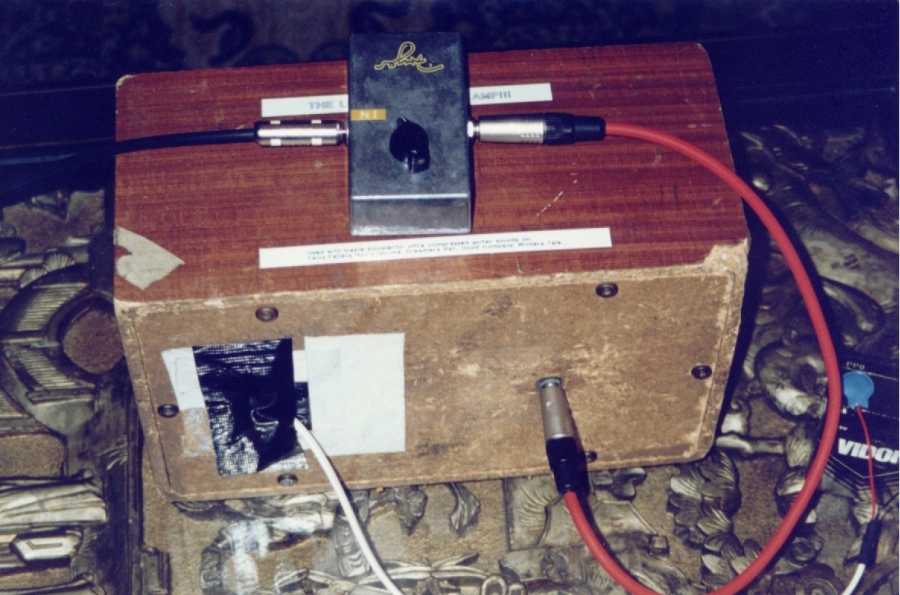
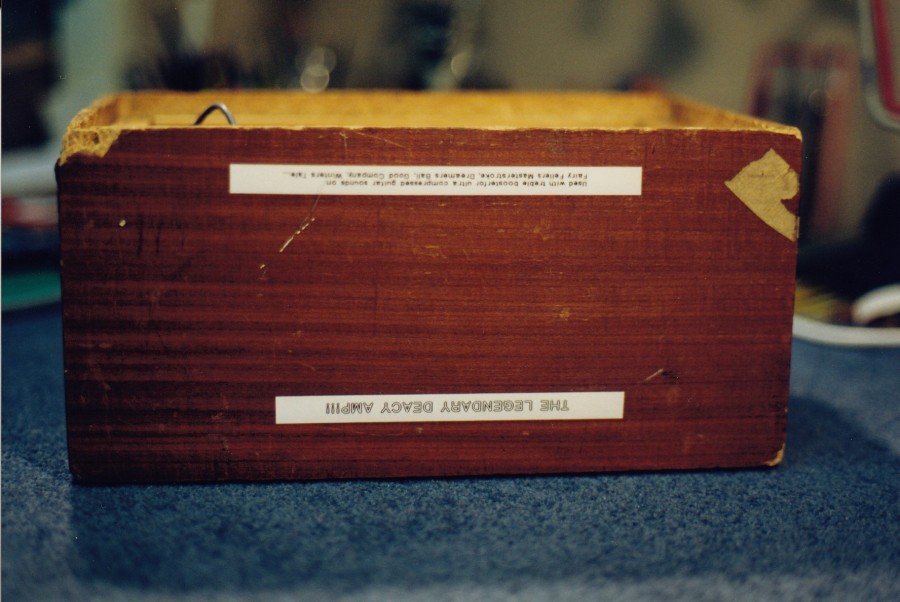


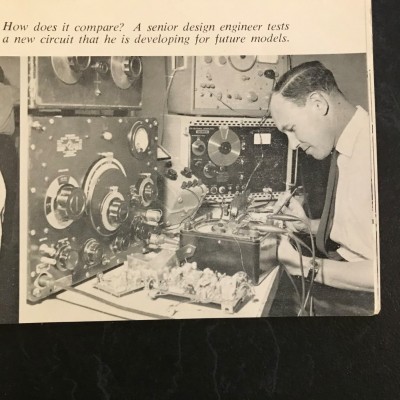

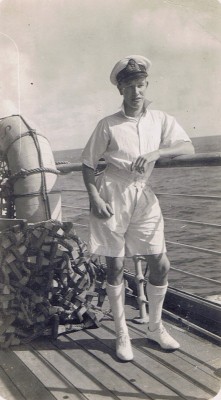
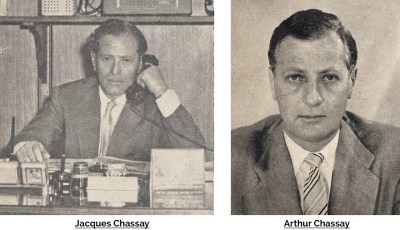
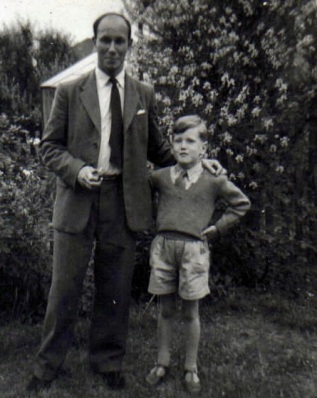

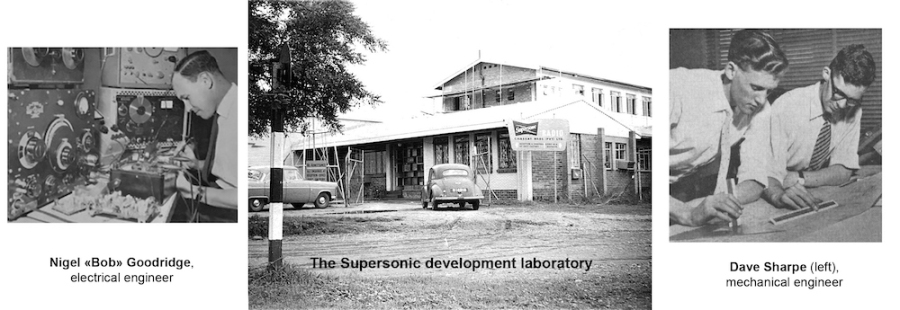


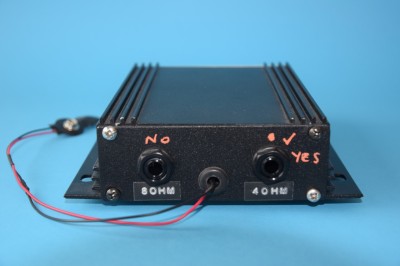
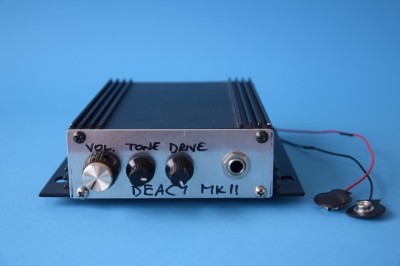
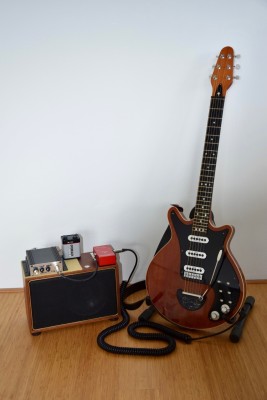
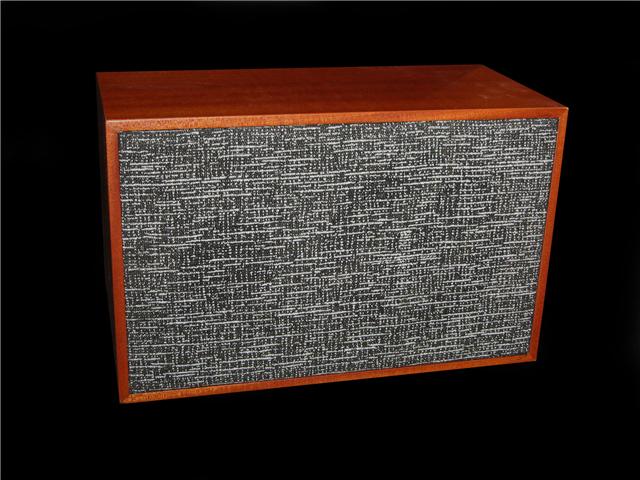
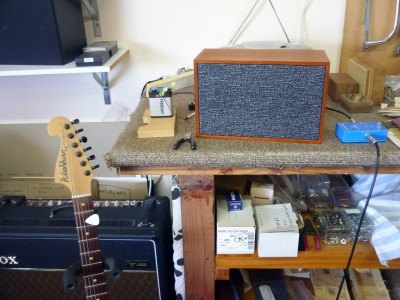
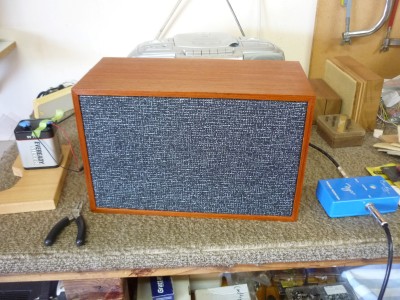

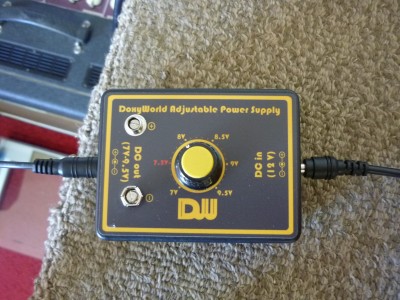
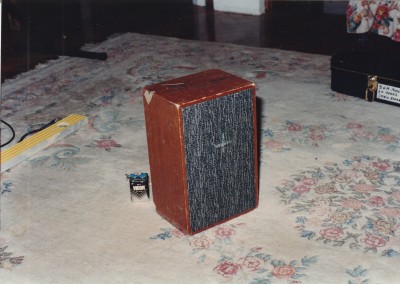
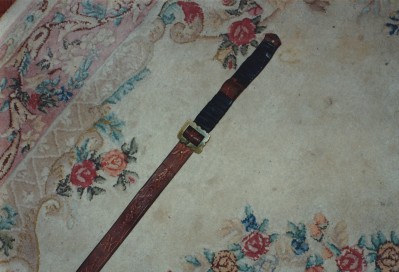
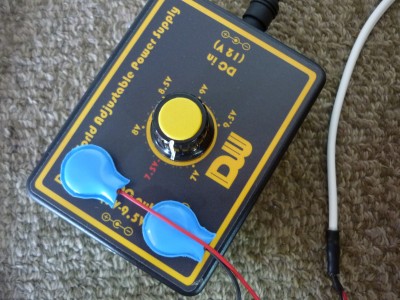
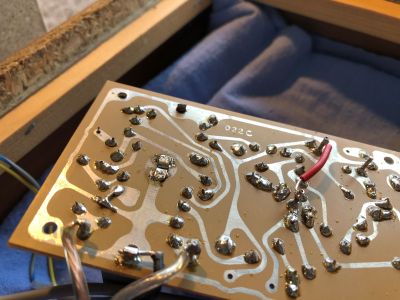
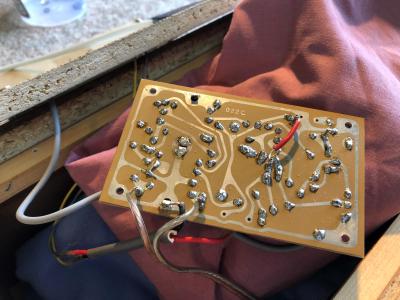
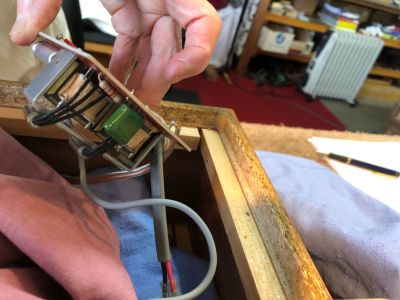
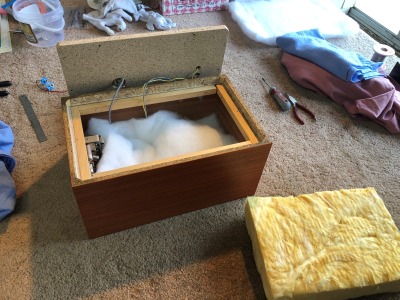
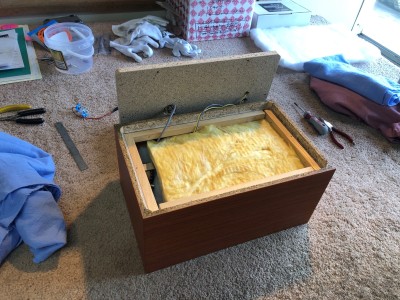
You must be logged in to post a comment.